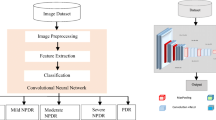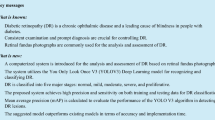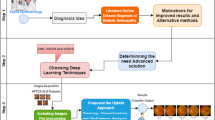Abstract
Diabetic retinopathy (DR) is the most common diabetic eye disease and a leading cause of blindness. It is an irreversible loss that needs to be detected early to save the patient’s vision. For early detection, premature symptoms of DR can be noticed in exudates, blood vessels, micro-aneurysms, and hemorrhages of the retinal eye surface. Thus, detecting grades of DR from individual features is an active area of research. This work aims to extract features from retinal images and classify DR to binary and multiclass classification. To detect different grades of DR, various machine learning classifiers are applied on individual and combined features. Deep learning models, i.e., convolution neural networks (CNNs), and its variants are also used to diagnose and classify the severity of DR accurately in multiple classes. A fine-tuned variant of VGG-19 model is introduced which uses the transfer learning approach and is evaluated on digital fundus retinal images for both binary and multiclass classification. Experimental results revealed that the fine-tuned model of VGG-19 performs better than contemporary CNN models and machine learning algorithms. On average, it improves by 37% from existing CNN models on multiclass classification. The work presented here provides an ophthalmologist the comprehensive way to detect the grades of diabetic retinopathy even from single feature only.













Similar content being viewed by others
References
Fong DS, Aiello L, Gardner TW, King GL, Blankenship G, Cavallerano JD, et al. Retinopathy in diabetes. Diabetes Care. 2004;27:s84–7.
Walter T, Klein JC, Massin P, Erginay A. A contribution of image processing to the diagnosis of diabetic retinopathy - detection of exudates in color fundus images of the human retina. IEEE Trans Med Imaging. 2002;21:1236–43. https://doi.org/10.1109/TMI.2002.806290.
Health N, Exam- N. The evolving diabetes burden in the United States. Ann Intern Med. 2004;140:4–10.
Akram MU, Khalid S, Tariq A, Khan SA, Azam F. Detection and classification of retinal lesions for grading of diabetic retinopathy. Computers in Biology and Medicine 2014:161–71.
Akram MU, Khalid S, Khan SA. Identification and classification of microaneurysms for early detection of diabetic retinopathy. Pattern Recogn. 2013;46:107–16. https://doi.org/10.1016/j.patcog.2012.07.002.
Biran A, Sobhe P, Bidari KR. Automatic method for exudates and hemorrhages detection from fundus retinal images. Int J Comp Electr Autom Control Inform Eng. 2016;9:1443–6.
Williamson TH, Gardner GG, Keating D, Kirkness CM, Elliott AT. Automatic detection of diabetic retinopathy using neural networks. Invest Ophthalmol vis Sci. 1996;37:940–4.
Zohra BF, Mohamed B. Automated diagnosis of retinal images using the Support Vector Machine(SVM). Faculte Des Science, Department of Informatique, USTO, Algerie 2009.
R. P, P. A. Diagnosis of diabetic retinopathy using machine learning techniques. ICTACT Journal on Soft Computing 2013;03:563–75. https://doi.org/10.21917/ijsc.2013.0083.
Shin HC, Roth HR, Gao M, Lu L, Xu Z, Nogues I, et al. Deep convolutional neural networks for computer-aided detection: CNN architectures, dataset characteristics and transfer learning. IEEE Trans Med Imaging. 2016;35:1285–98. https://doi.org/10.1109/TMI.2016.2528162.
Solkar S, Das L. A New approach for detection and classification of diabetic retinopathy using PNN and SVM classifiers. IOSR J Comput Eng. 2017;19:62–8.
Faust O, Acharya UR, Ng EYK, Ng KH, Suri JS. Algorithms for the automated detection of diabetic retinopathy using digital fundus images: a review. J Med Syst. 2012;36:145–57. https://doi.org/10.1007/s10916-010-9454-7.
Rakhlin A. Diabetic retinopathy detection through integration of deep learning classification framework. BioRxiv 2018:225508. https://doi.org/10.1101/225508.
Pratt H, Coenen F, Broadbent DM, Harding SP, Zheng Y. Convolutional neural networks for diabetic retinopathy. Procedia Comput Sci. 2016;90:200–5. https://doi.org/10.1016/j.procs.2016.07.014.
Gulshan V, Peng L, Coram M, Stumpe MC, Wu D, Narayanaswamy A, et al. Development and validation of a deep learning algorithm for detection of diabetic retinopathy in retinal fundus photographs. JAMA. 2016;316:2402–10. https://doi.org/10.1001/jama.2016.17216.
Galar M, Fernandez A, Barrenechea E, Bustince H, Herrera F. A review on ensembles for the class imbalance problem: bagging-, boosting-, and hybrid-based approaches. IEEE Trans Syst Man Cybern Part C Appl Rev. 2012;42:463–84. https://doi.org/10.1109/TSMCC.2011.2161285.
Roychowdhury S, Koozekanani DD, Parhi KK. DREAM: diabetic retinopathy analysis using machine learning. IEEE J Biomed Health Inform. 2014;18:1717–28. https://doi.org/10.1109/JBHI.2013.2294635.
Antal B, Hajdu A. An ensemble-based system for automatic screening of diabetic retinopathy. Knowl-Based Syst. 2014;60:20–7. https://doi.org/10.1016/j.knosys.2013.12.023.
Xu K, Feng D, Mi H. Deep convolutional neural network-based early automated detection of diabetic retinopathy using fundus image. Molecules 2017;22. https://doi.org/10.3390/molecules22122054.
Sathiya G, Gayathri P. Automated detection of diabetic retinopathy using GLCM. Int J Appl Eng Res. 2014;9:7019–27.
Wan S, Liang Y, Zhang Y. Deep convolutional neural networks for diabetic retinopathy detection by image classification. Comput Electr Eng. 2018;72:274–82. https://doi.org/10.1016/j.compeleceng.2018.07.042.
Mobeen-Ur-Rehman, Khan SH, Abbas Z, Danish Rizvi SM. Classification of diabetic retinopathy images based on customised CNN architecture. Proceedings - 2019 Amity International Conference on Artificial Intelligence, AICAI 2019 2019:244–8. https://doi.org/10.1109/AICAI.2019.8701231.
Alyoubi WL, Shalash WM, Abulkhair MF. Diabetic retinopathy detection through deep learning techniques: a review. Inform Med Unlocked. 2020;20:100377. https://doi.org/10.1016/j.imu.2020.100377.
Harshitha C, Asha A, Pushkala JLS, Anogini RNS, C K. Predicting the stages of diabetic retinopathy using deep learning. 2021 6th International Conference on Inventive Computation Technologies (ICICT), 2021, p. 1–6. https://doi.org/10.1109/ICICT50816.2021.9358801.
Shankar K, Sait ARW, Gupta D, Lakshmanaprabu SK, Khanna A, Pandey HM. Automated detection and classification of fundus diabetic retinopathy images using synergic deep learning model. Pattern Recogn Lett. 2020;133:210–6. https://doi.org/10.1016/j.patrec.2020.02.026.
Panchal P, Bhojani R, Panchal T. An algorithm for retinal feature extraction using hybrid approach. Procedia Comput Sci. 2016;79:61–8. https://doi.org/10.1016/j.procs.2016.03.009.
Soomro TA, Paul M, Gao J, Zheng L. Retinal blood vessel extraction method based on basic filtering schemes. Proceedings - International Conference on Image Processing, ICIP 2018;2017-Septe:4422–6. https://doi.org/10.1109/ICIP.2017.8297118.
Bae JP, Kim KG, Kang HC, Jeong CB, Park KH, Hwang JM. A study on hemorrhage detection using hybrid method in fundus images. J Digit Imaging. 2011;24:394–404. https://doi.org/10.1007/s10278-010-9274-9.
Hearst MA, Dumais ST, Osuna E, Platt J, Scholkopf B. Support vector machines. IEEE Intelligent Systems and Their Applications. 1998;13:18–28.
Min-Ling Zhang, Zhi-Hua Zhou. A k-nearest neighbor based algorithm for multi-label classification. IEEE international conference on granular computing, 2005, p. 718–721 Vol. 2. https://doi.org/10.1109/grc.2005.1547385.
Liaw A, Wiener M. Classification and regression by random forest. R News. 2003;2(3):18–22.
Rätsch G, Onoda T, Müller KR. Soft margins for AdaBoost. Mach Learn. 2001;42:287–320. https://doi.org/10.1023/A:1007618119488.
Zeiler MD, Fergus R. Visualizing and understanding convolutional networks. European conference on computer vision, Springer, Cham; 2014.
Iandola FN, Han S, Moskewicz MW, Ashraf K, Dally WJ, Keutzer K. SqueezeNet: AlexNet-level accuracy with 50x fewer parameters and <0.5MB model size. ArXiv Preprint ArXiv:160207360 2016:1–13.
Ballester P, Araujo RM. On the performance of googlenet and alexnet applied to sketches. 30th AAAI Conference on Artificial Intelligence, AAAI 2016 2016:1124–8.
Simonyan K, Zisserman A. Very deep convolutional networks for large-scale image recognition. International Conference on Learning Representations, 2015, p. 1–14.
Mateen M, Wen J, Nasrullah, Song S, Huang Z. Fundus image classification using VGG-19 architecture with PCA and SVD. Symmetry 2019;11. https://doi.org/10.3390/sym11010001.
Chollet F. Xception: Deep learning with depthwise separable convolutions. Proc IEEE Conf Comput vis Pattern Recognit. 2017;7:1251–8. https://doi.org/10.4271/2014-01-0975.
Szegedy C, Vanhoucke V, Ioffe S, Shlens J, Wojna Z. Rethinking the inception architecture for computer vision. Proceedings of the IEEE Computer Society Conference on Computer Vision and Pattern Recognition 2016;2016-Decem:2818–26. https://doi.org/10.1109/CVPR.2016.308.
Nguyen QH, Muthuraman R, Singh L, Sen G, Tran AC, Nguyen BP, et al. Diabetic retinopathy detection using deep learning. ACM International Conference Proceeding Series, vol. 5, Haiphong City, Viet Nam. ACM; 2020, p. 103–7. https://doi.org/10.1145/3380688.3380709.
Author information
Authors and Affiliations
Corresponding author
Ethics declarations
Ethics approval
This article does not contain any studies with human participants or animals performed by any of the authors.
Conflict of interest
The author declare no competing interests.
Additional information
Publisher's note
Springer Nature remains neutral with regard to jurisdictional claims in published maps and institutional affiliations.
Rights and permissions
About this article
Cite this article
Dutta, A., Agarwal, P., Mittal, A. et al. Detecting grades of diabetic retinopathy by extraction of retinal lesions using digital fundus images. Res. Biomed. Eng. 37, 641–656 (2021). https://doi.org/10.1007/s42600-021-00177-w
Received:
Accepted:
Published:
Issue Date:
DOI: https://doi.org/10.1007/s42600-021-00177-w




